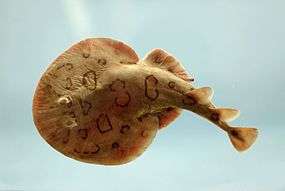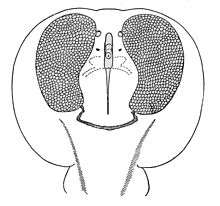Electric ray
The electric rays are a group of rays, flattened cartilaginous fish with enlarged pectoral fins, composing the order Torpediniformes. They are known for being capable of producing an electric discharge, ranging from 8 to 220 volts, depending on species, used to stun prey and for defense.[2] There are 69 species in four families.
| Electric rays | |
|---|---|
 | |
| Marbled electric ray (Torpedo marmorata) | |
 | |
| Lesser electric ray (Narcine bancroftii) | |
| Scientific classification | |
| Kingdom: | |
| Phylum: | |
| Class: | |
| Subclass: | |
| Superorder: | |
| Order: | Torpediniformes F. de Buen, 1926 |
Perhaps the best known members are those of the genus Torpedo, also called crampfish and numbfish. The torpedo is named after it. The name comes from the Latin torpere, to be stiffened or paralyzed, referring to the effect on someone who handles or steps on a living electric ray.
Description
Electric rays have a rounded pectoral disc with two moderately large rounded-angular (not pointed or hooked) dorsal fins (reduced in some Narcinidae), and a stout muscular tail with a well-developed caudal fin. The body is thick and flabby, with soft loose skin with no dermal denticles or thorns. A pair of kidney-shaped electric organs are at the base of the pectoral fins. The snout is broad, large in the Narcinidae, but reduced in all other families. The mouth, nostrils, and five pairs of gill slits are underneath the disc.[2][3]
Electric rays are found from shallow coastal waters down to at least 1,000 m (3,300 ft) deep. They are sluggish and slow-moving, propelling themselves with their tails, not by using their pectoral fins as other rays do. They feed on invertebrates and small fish. They lie in wait for prey below the sand or other substrate, using their electricity to stun and capture it.[4]
Relationship to humans
The electrogenic properties of electric rays have been known since antiquity. The ancient Greeks used electric rays to numb the pain of childbirth and operations.[2] In his dialogue Meno, Plato has the character Meno accuse Socrates of "stunning" people with his puzzling questions, in a manner similar to the way the torpedo fish stuns with electricity.[5] Scribonius Largus, a Roman physician, recorded the use of torpedo fish for treatment of headaches and gout in his Compositiones Medicae of 46 AD.[6] The torpedo fish, or electric ray, appears continuously in premodern natural histories as a magical creature, and its ability to numb fishermen without seeming to touch them was a significant source of evidence for the belief in occult qualities in nature during the ages before the discovery of electricity as an explanatory mode.[7]
Bioelectricity

The electric ray may be the most electrosensitive of all animals. Their eyes are on the top of their heads, resulting in poor vision that must be compensated for the use of other senses, including detecting electricity. Many species of rays and skates outside the family have electric organs in the tail; however, the electric ray has two large electric organs on each side of its head, where current passes from the lower to the upper surface of the body. The organs are governed by four central nerves from each side of the electric lobe, or specialized brain lobe, which is of a different color from the rest of the brain. The main nerves branch repeatedly, then attach to the lower side of each plate in the batteries, which are composed of hexagonal columns, in honeycomb formation: each column consists of 140 to half a million gelatinous plates. In marine fish, these batteries are connected as a parallel circuit where freshwater batteries are found in series, transmitting discharges of higher voltage, as freshwater cannot conduct electricity as well as saltwater. With such a battery, an average electric ray may electrocute larger prey with a current of up to 30 amperes and a voltage of 50 to 200 volts, a similar effect to dropping a mains-powered hairdryer (large appliance plug of 110/220 volts in North America) into a bathtub.
Systematics
The 60 or so species of electric rays are grouped into 12 genera and two families.[8] The Narkinae are sometimes elevated to a family, the Narkidae. The torpedinids feed on large prey, which are stunned using their electric organs and swallowed whole, while the narcinids specialize on small prey on or in the bottom substrate. Both groups use electricity for defense, but it is unclear whether the narcinids use electricity in feeding.[9]
- Family Narcinidae (numbfishes)
- Subfamily Narcininae
- Genus Benthobatis
- Genus Diplobatis
- Genus Discopyge
- Genus Narcine
- Subfamily Narkinae (sleeper rays)
- Genus Crassinarke
- Genus Electrolux
- Genus Heteronarce
- Genus Narke
- Genus Temera
- Genus Typhlonarke
- Subfamily Narcininae
- Family Hypnidae (coffin rays)
- Family Torpedinidae (torpedo electric rays)
- Subfamily Torpedininae
- Genus Tetronarce
- Genus Torpedo
- Subfamily Torpedininae
See also
- Endangered rays
- Electric fish
References
- Froese, Rainer, and Daniel Pauly, eds. (2011). "Torpediniformes" in FishBase. February 2011 version.
- Martin, R. Aidan. Electric Rays. ReefQuest Centre for Shark Research. Retrieved on October 12, 2008.
- Hamlett, William C. (1999). Sharks, Skates, and Rays: The Biology of Elasmobranch Fishes. Baltimore and London: JHU Press. ISBN 0-8018-6048-2.
- Stevens, J.; Last, P.K. (1998). Paxton, J.R.; Eschmeyer, W.N. (eds.). Encyclopedia of Fishes. San Diego: Academic Press. p. 66. ISBN 0-12-547665-5.
- Wikisource:Meno
- Theodore Holmes Bullock; Carl D. Hopkins; Richard R. Fay (28 September 2006). Electroreception. Springer Science & Business Media. p. 6. ISBN 978-0-387-28275-6.
- Copenhaver, Brian P. (September 1991). "A tale of two fishes: Magical objects in natural history from antiquity through the scientific revolution". Journal of the History of Ideas. 52 (3): 373–398. doi:10.2307/2710043.
- Nelson, J.S. (2006). Fishes of the World (fourth ed.). John Wiley. pp. 69–82. ISBN 0-471-25031-7.
- Compagno, Leonard J.V. and Heemstra, Phillip C. (May 2007) "Electrolux addisoni, a new genus and species of electric ray from the east coast of South Africa (Rajiformes: Torpedinoidei: Narkidae), with a review of torpedinoid taxonomy". Smithiana, Publications in Aquatic Biodiversity, Bulletin 7: 15-49. Retrieved on October 22, 2008.